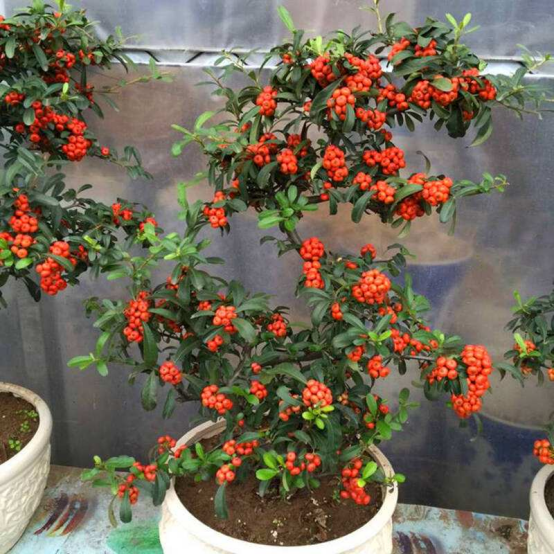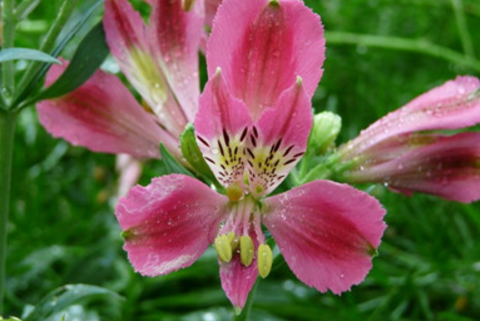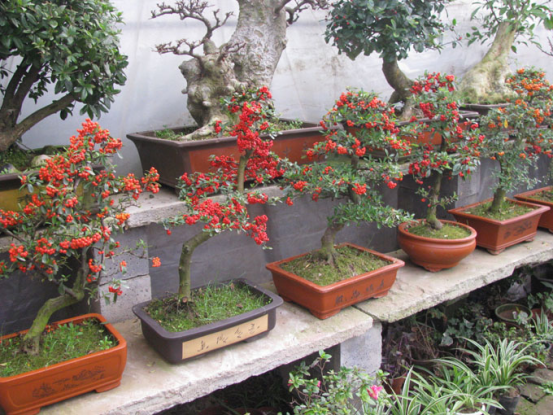Modeling and making of firethorn bonsai
Firethorn bonsai should adopt the modeling method of coarse binding and fine cutting, which is generally carried out in autumn. first, iron wire or brown wire is used to roughly tie the trunk into different forms such as oblique stem or lying dry, and then it is cultivated for a period of time, and then the pile landscape layer is trimmed and shaped according to the design, so that the whole tree shape has a clear lasting appeal. In the process of maintenance, we need to observe the growth of Hippophae rhamnoides, think more, and repeatedly trim, shape, pick the heart, wipe buds and other operations in order to maintain the beauty of the tree.

At this point, the production method of firethorn bonsai is over, is it much simpler than imagined? I hope the editor's introduction is helpful to you!
How to make firethorn bonsai
Firethorn bonsai with luxuriant branches and leaves is an excellent household potted plant for viewing flowers in spring and fruit in autumn. Many flower lovers will raise them at home, but many people don't know how to make firethorn bonsai. Today, I will tell you about the method of making firethorn bonsai.
1. Mining pile
Firethorn growth ability is tenacious, generally collect up to a hundred years of wild piles as a bonsai production seedling source. This kind of old pile branch is easy to sprout, almost all the buds will germinate in spring, but the formed branches are relatively weak, usually only 1-2 buds at the top can germinate and grow strong mature branches above 45cm. The new branches have good toughness and can withstand banding in all directions. Even if there is a slight sound, they do not have to worry about breaking. They can be trimmed into various shapes.
2. Cuttage
Cutting time:
This time is uncertain, some think it is September, and some take place in spring or Meiyu period. In general, it differentiates flower buds in July and August, and this process is basically completed in September, when the temperature is still high, slowly cool, in line with the habits of Pyracantha, the obtained seedling source for cutting survival rate is very high, will grow better.
Cutting process:
① cuttings, select relatively luxuriant branches, take its growth 10-15cm section, the upper need to retain two pairs of leaves, the lower can choose not to remain.
② matrix, using river sand or loose permeable soil. The river sand can be washed clean with boiling water, and the cultivated soil can be disinfected by sunlight or 50 times formalin solution.
Cutting, first, it is inserted into the river sand, cultured in a semi-shady environment full of water for one month, and then transferred to the culture soil through winter in the cold room; second, it is carried out directly in the culture soil without river sand culture. Each seedling was inserted into the corresponding bowl respectively, and the optimum temperature was 20-25 ℃, and the roots would grow in about a month.
3. Modeling
If the firethorn stump in the pot at the beginning of the year is properly maintained, the soil, fertilizer, water and insect control can keep up, and the new branches can grow to 60cm~80cm from July to August. At this time, the first styling and pruning should be carried out. According to the stump shape, the design idea is carried out according to the timber intention, and in line with the overall situation, acting in accordance with their aptitude and complying with the modeling principle of nature, do not leave only 3mur5 branches and cut off all the other branches. Except for parallel branches, overlapping branches, crossed branches and cut dry branches, other branches should not be cut as far as possible. If there is any surplus in the future, it will not affect the whole tree shape if you keep it while cutting it.
For the retained thick and main branches, the thicker aluminum wire is used to strongly twist in place and set at once. For the twigs on the main branch, tie the branch with thin aluminum wire to locate, first tie the top and then the lower part, first tie the big branch, then tie the twig, from the base to the tip. When winding, wrap one end of the aluminum wire around the trunk to fix it. The aluminum wire should be glued to the bark and wound evenly at an angle of 45 °with the trunk diameter to the top.
According to the needs of the shape, the branch bends to the right and the aluminum wire should be wound clockwise; if the branch bends to the left and downward, the aluminum wire should be wound counterclockwise. The vitality of Hippophae rhamnoides is extremely strong, and the flexibility of the branches is also very good. In modeling, even if the twist is broken, as long as there is still a layer of skin unbroken, it still does not affect its normal growth. It is usually removed after 60 days with aluminum wire.
The second styling trimming is carried out from September to October. After the first pruning, the outline of the crown has basically taken shape. at this time, it depends on whether the roots, stems, branches and leaves of the bonsai are natural, smooth and dense, cut off the excess branches, keep the short branches, and observe and think more in the process of maintenance. need to be repeatedly flat binding, pruning, modeling, heart-picking, sprout in order to maintain a beautiful tree shape.
The above is for you to introduce the firethorn bonsai production method, I hope it can help you, more household knowledge, please pay attention.
The cultivation and pruning of Firethorn and the making method of Firethorn Bonsai
Firethorn, also known as torch fruit, is a plant of the genus Hippophae rhamnoides of Rosaceae. Evergreen shrub or small tree having long oval leaves and globose fruit and crimson at maturity. There are yellow and orange fruits in horticulture.
Kind of. Originated in China, like warm and slightly dry climate and sufficient light, slightly resistant to shade. The suitable temperature for growth is 15-25 degrees.
1. Layout
When the fruit is red, the trees are as red as fire, with luxuriant branches and leaves, which is a good material for making bonsai. Bonsai should be arranged separately on the flower rack.
2. Cultivation in four seasons
(1) Spring is suitable to be arranged on the balcony facing east, south and west. Hippophae rhamnoides is to watch flowers, watch fruit bonsai, generally 1 ~ 2 years to change pots. Hippophae rhamnoides has strong adaptability to soil and does not have high requirements for soil. It is best to use fertile and loose loam in the basin. The new soil should be mixed with a little mature cow dung and bone meal to meet the nutrition needed for the flowering and fruiting of Hippophae rhamnoides. The soil must be compacted when changing the basin. Hippophae rhamnoides has strong growth and strong adaptability. Adequate light should be ensured in spring to keep the soil moist. At flowering stage, the soil should be prevented from drying early and fertilized properly.
(2) it is suitable to be arranged on the balcony in the east, south, west and north dynasties in summer. Hippophae rhamnoides likes enough light and can withstand high temperatures in summer. However, the leaves of Hippophae rhamnoides are easy to yellowing under high temperature and strong light, so bonsai should be moved to semi-shade when high temperature is accompanied by strong light in summer. Cultivating in semi-shade can also reduce the water evaporation of Hippophae rhamnoides and reduce the number of watering. At the end of summer, bonsai should be moved to a place with plenty of light for cultivation. Attention should be paid to the management of moisture in summer to prevent drying early.
(3) it is suitable to be arranged on the balcony of the east, south, west and north dynasties in autumn. September to November is the red fruit season, but also the best viewing season. It can be arranged in the east, south and west balcony with light, or in the north balcony with bright light. Keep the basin soil moist.
(4) it is suitable to be arranged on the balcony facing east, south and west in winter. Firethorn dormancy in winter, extremely resistant to low temperature, but firethorn bonsai should be about 0 ℃ indoor overwintering. The wetlands are watered to ensure a certain amount of light. If the winter is properly managed, the viewing period can be extended to the following spring.
3. Pruning
Hippophae rhamnoides is strong in germination and resistant to pruning. Firethorn blossoms more on short branches, so longer branches are also called vegetative branches, which can be cut short by 1-2 nodes to turn them into fruiting branches, so that many branches can be spent. In the modeling can be cut off long branches, parallel branches, cross branches, disease and insect branches, sprouting millet branches. When the branches grow too dense, some branches can be cut and thinned properly.
4. the production of firethorn bonsai.
(1) the characteristics of firethorn bonsai are luxuriant branches and leaves. After autumn, a string of red fruits hang all over the branches, which does not fall for a long time, like coral fruit, dazzling. And the branches are resistant to pruning and binding, so it is easy to shape.
(2) Hippophae rhamnoides is generally cultivated and bred by itself. It can be propagated by cutting or sowing, and firethorn cuttings grow rapidly. Sturdy firethorns can also be bought on the market. It is best to choose and buy potted seedlings, because Pyracantha is taproot, it is not easy to survive when transplanting, especially bare-root seedlings transplanting is more difficult to survive. Buy potted seedlings, preferably with soil balls. You can also buy rough billets with basic shapes for processing.
(3) the common shapes of firethorn bonsai are luxuriant branches and leaves, evergreen leaves, red fruits hanging on the branches in autumn, festive red fire, not withering in winter, and branches resistant to pruning and binding, which can be made into various forms of bonsai, such as jungle type, curved dry type, straight dry type, oblique dry type and so on.
(4) the modeling method of firethorn bonsai the branches of Hippophae rhamnoides are hard and brittle and easy to break. Because of its strong germinating power, the Lingnan School "storing branches and cutting dry method" is often used in modeling, and the purpose of bending the branches is achieved through pruning. In this way, the branches of bonsai are bent at an angle, dense branches and iron bones. It can also be tied up with iron wire to make the branches into pieces, and its natural body can also be used to make jungle bonsai.
- Prev

Propagation methods of six-flowered flowers
Sowing and reproduction of six flowers are usually sown in winter. Sand and peat soil can be mixed as the sowing medium. The seeds gradually wake up at low temperature, and then move to a place of 15-20 ℃. After two weeks, the seeds can germinate and continue to maintain a warm environment. When the seedlings grow to four or five centimeters, they can be cultivated separately.
- Next

Propagation Management of Pyracantha
Generally speaking, we adopt sowing propagation or cutting propagation for the propagation of Pyracantha, but the cutting propagation is simple and successful. Cuttage propagation uses annual healthy branches, cutting cuttings of 15 cm, the lower end is best cut out horseear shape, the cutting time can be carried out from November to March, and the success rate of cutting is very high.
Related
- Fuxing push coffee new agricultural production and marketing class: lack of small-scale processing plants
- Jujube rice field leisure farm deep ploughing Yilan for five years to create a space for organic food and play
- Nongyu Farm-A trial of organic papaya for brave women with advanced technology
- Four points for attention in the prevention and control of diseases and insect pests of edible fungi
- How to add nutrient solution to Edible Fungi
- Is there any good way to control edible fungus mites?
- Open Inoculation Technology of Edible Fungi
- Is there any clever way to use fertilizer for edible fungus in winter?
- What agents are used to kill the pathogens of edible fungi in the mushroom shed?
- Rapid drying of Edible Fungi

